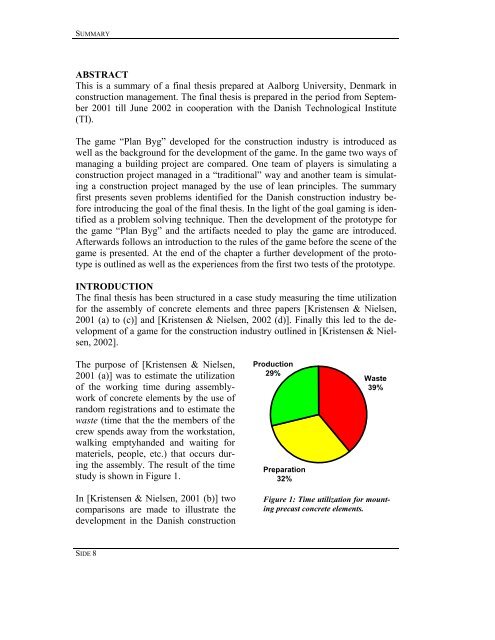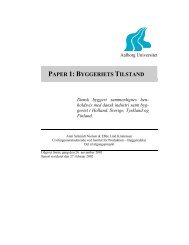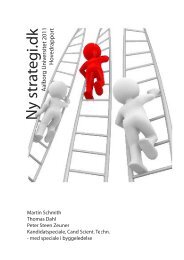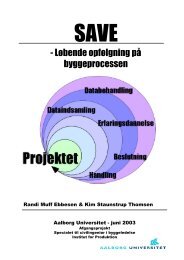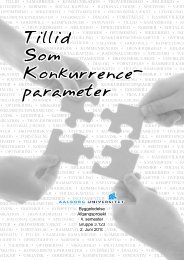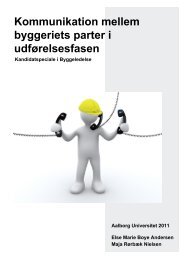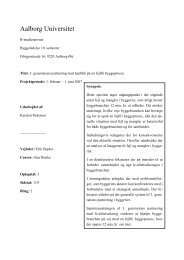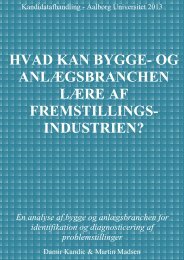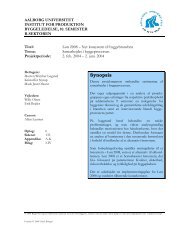Institut for produktion Civilingeniøruddannelsen i Byggeledelse
Institut for produktion Civilingeniøruddannelsen i Byggeledelse
Institut for produktion Civilingeniøruddannelsen i Byggeledelse
Create successful ePaper yourself
Turn your PDF publications into a flip-book with our unique Google optimized e-Paper software.
SUMMARY<br />
ABSTRACT<br />
This is a summary of a final thesis prepared at Aalborg University, Denmark in<br />
construction management. The final thesis is prepared in the period from September<br />
2001 till June 2002 in cooperation with the Danish Technological <strong>Institut</strong>e<br />
(TI).<br />
The game “Plan Byg” developed <strong>for</strong> the construction industry is introduced as<br />
well as the background <strong>for</strong> the development of the game. In the game two ways of<br />
managing a building project are compared. One team of players is simulating a<br />
construction project managed in a “traditional” way and another team is simulating<br />
a construction project managed by the use of lean principles. The summary<br />
first presents seven problems identified <strong>for</strong> the Danish construction industry be<strong>for</strong>e<br />
introducing the goal of the final thesis. In the light of the goal gaming is identified<br />
as a problem solving technique. Then the development of the prototype <strong>for</strong><br />
the game “Plan Byg” and the artifacts needed to play the game are introduced.<br />
Afterwards follows an introduction to the rules of the game be<strong>for</strong>e the scene of the<br />
game is presented. At the end of the chapter a further development of the prototype<br />
is outlined as well as the experiences from the first two tests of the prototype.<br />
INTRODUCTION<br />
The final thesis has been structured in a case study measuring the time utilization<br />
<strong>for</strong> the assembly of concrete elements and three papers [Kristensen & Nielsen,<br />
2001 (a) to (c)] and [Kristensen & Nielsen, 2002 (d)]. Finally this led to the development<br />
of a game <strong>for</strong> the construction industry outlined in [Kristensen & Nielsen,<br />
2002].<br />
The purpose of [Kristensen & Nielsen,<br />
2001 (a)] was to estimate the utilization<br />
of the working time during assemblywork<br />
of concrete elements by the use of<br />
random registrations and to estimate the<br />
waste (time that the the members of the<br />
crew spends away from the workstation,<br />
walking emptyhanded and waiting <strong>for</strong><br />
materiels, people, etc.) that occurs during<br />
the assembly. The result of the time<br />
study is shown in Figure 1.<br />
In [Kristensen & Nielsen, 2001 (b)] two<br />
comparisons are made to illustrate the<br />
development in the Danish construction<br />
SIDE 8<br />
Production<br />
29%<br />
Preparation<br />
32%<br />
Waste<br />
39%<br />
Figure 1: Time utilization <strong>for</strong> mounting<br />
precast concrete elements.


